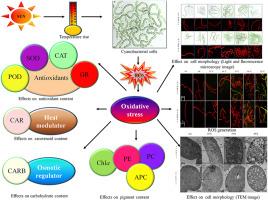Effects of temperature on morphology, physiology, and metabolic profile of diazotrophic cyanobacteria inhabiting diverse habitats
IF 6.1
2区 生物学
Q1 PLANT SCIENCES
引用次数: 0
Abstract
Global population expansion has increased the demand for food supply and agricultural productivity. Abiotic stressors like temperature have significantly restricted agriculture in cropland and jeopardized food security. Cyanobacteria play a crucial role in fostering sustainable agriculture and ensuring global food security. In the present study, we have assessed the effect of temperatures on diazotrophic free living rice-field and hot-spring cyanobacteria. They were treated to a variable range of temperatures to see the changes in cellular morphology, physiology, and biochemical characteristics. The rise of temperatures induces growth (60 %), total protein (54 %) contents of rice-field cyanobacterium until 25 °C, further treatment results in decline (20 %) at 45 °C. However, growth indices were increased till 35 °C (90 %) in hot-spring cyanobacterium and further treatment did not exhibit a significant decline in the same. However, the reactive oxygen species (ROS) generation and lipid peroxidation (LPO) were higher in rice-field (2.8 and 1.7 fold) as compared to hot-spring cyanobacterium (2.2 and 1.6 fold). In response to temperature, enzymatic antioxidant contents were much higher in hot-spring as compared to rice-field cyanobacterium. Similarly, carotenoid and carbohydrate content was also higher in hot spring (2 fold) as compared to rice-field cyanobacterium (1.5 and 1.2 fold). All these data collectively suggest that hot-spring (Nostoc sp. strain VKB02) has a higher thermoprotective capacity with novel defense mechanisms as compared to rice-field cyanobacterium (Anabaena sp. strain VKB01). These findings contributed to a better understanding of the temperature stress, improvement of agricultural productivity and future welfare of green ecosystems.

温度对栖息于不同生境的重氮蓝藻的形态、生理和代谢特征的影响。
全球人口膨胀增加了对粮食供应和农业生产力的需求。温度等非生物压力大大限制了耕地农业的发展,危及粮食安全。蓝藻在促进可持续农业和确保全球粮食安全方面发挥着至关重要的作用。在本研究中,我们评估了温度对重氮自由活体稻田蓝藻和温泉蓝藻的影响。在不同的温度范围内对它们进行处理,以观察细胞形态、生理和生化特征的变化。温度升高可促进稻田蓝藻的生长(60%)和总蛋白含量(54%),直至 25 °C;温度升高到 45 °C,生长指数下降(20%)。然而,温泉蓝藻的生长指数在 35 ℃ 前有所上升(90%),进一步处理后也没有出现明显下降。然而,与热泉蓝藻(2.2 倍和 1.6 倍)相比,稻田蓝藻产生的活性氧(ROS)和脂质过氧化(LPO)更高(2.8 倍和 1.7 倍)。与稻田蓝藻相比,热泉蓝藻的酶抗氧化剂含量对温度的反应要高得多。同样,与稻田蓝藻(1.5 倍和 1.2 倍)相比,温泉蓝藻的类胡萝卜素和碳水化合物含量也更高(2 倍)。所有这些数据共同表明,与稻田蓝藻(Anabaena sp.菌株 VKB01)相比,温泉蓝藻(Nostoc sp.菌株 VKB02)具有更高的热保护能力和新型防御机制。这些发现有助于更好地理解温度胁迫,提高农业生产力和绿色生态系统的未来福祉。
本文章由计算机程序翻译,如有差异,请以英文原文为准。
求助全文
约1分钟内获得全文
求助全文
来源期刊
CiteScore
11.10
自引率
3.10%
发文量
410
审稿时长
33 days
期刊介绍:
Plant Physiology and Biochemistry publishes original theoretical, experimental and technical contributions in the various fields of plant physiology (biochemistry, physiology, structure, genetics, plant-microbe interactions, etc.) at diverse levels of integration (molecular, subcellular, cellular, organ, whole plant, environmental). Opinions expressed in the journal are the sole responsibility of the authors and publication does not imply the editors'' agreement.
Manuscripts describing molecular-genetic and/or gene expression data that are not integrated with biochemical analysis and/or actual measurements of plant physiological processes are not suitable for PPB. Also "Omics" studies (transcriptomics, proteomics, metabolomics, etc.) reporting descriptive analysis without an element of functional validation assays, will not be considered. Similarly, applied agronomic or phytochemical studies that generate no new, fundamental insights in plant physiological and/or biochemical processes are not suitable for publication in PPB.
Plant Physiology and Biochemistry publishes several types of articles: Reviews, Papers and Short Papers. Articles for Reviews are either invited by the editor or proposed by the authors for the editor''s prior agreement. Reviews should not exceed 40 typewritten pages and Short Papers no more than approximately 8 typewritten pages. The fundamental character of Plant Physiology and Biochemistry remains that of a journal for original results.

 求助内容:
求助内容: 应助结果提醒方式:
应助结果提醒方式:


